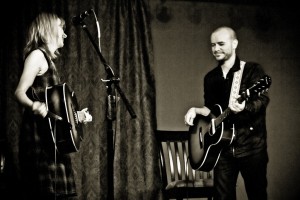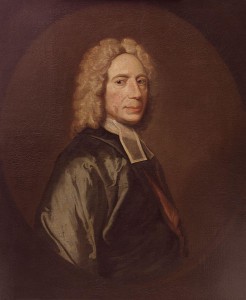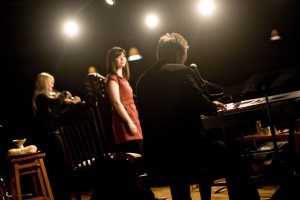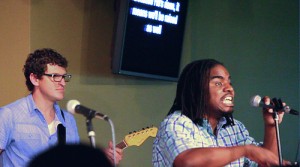Modern Hymns
WHAT ARE MODERN HYMNS?
When people speak of “modern hymns” they usually mean one of two things:
- Old hymn texts, written by masters like Isaac Watts, Charles Wesley, Anne Steele, John Newton, William Cowper and others, then set to contemporary melodies by the likes of Sandra McCracken and those in worship communities like Indelible Grace, Bifrost Arts, Page CXVI, Cardiphonia or Red Mountain Music. Some of these artists also revise and arrange the original texts, and may add choruses as well.
- Completely new hymns, written in hymn meter by contemporary hymnodists like Stuart Townend and Keith and Kristyn Getty.
 Kristen primarily composes hymn tunes. Bobby primarily writes & arranges texts
Kristen primarily composes hymn tunes. Bobby primarily writes & arranges texts
Our church Sojourn has recorded albums with songs in the former category (The Water And The Blood, Over The Grave) and the latter (Before The Throne). Some of my songs from these projects in the former category include “Let Your Blood Plead For Me,” “Warrior” and “We Are Changed.” In the latter, “Lead Us Back” and “All I Have Is Yours.” Other songwriting communities who do some of each include Sovereign Grace and Mars Hill (Seattle).
Kristen and I wrote “My Song In The Night,” the theme song of this website, after being inspired by an anonymous American folk hymn text of the same title. We only included two lines from the original, though.
WHAT KIND OF SONGWRITERS NEED TO KNOW ABOUT HYMN-WRITING?
You will benefit from understanding the mechanics of hymn text-writing, including form and meter, if:
- You are a writer/musician/tunesmith who arranges old hymn texts, adds choruses to hymn texts, or composes new music for old hymn texts – even if you aren’t altering lyrics (for more on composing new music for hymn texts and other pre-existing lyrics, click here).
- You write songs of any kind, style or genre, and want to expand your range and repertoire of songwriting techniques.
- You want to write modern hymns – lyric and melody.
TELL ME HOW TO WRITE A HYMN, COMPARED TO HOW TO WRITE OTHER SONGS
 Sandra McCracken & Derek Webb have taught in songwriting Q&As and panels for our church, Sojourn, and performed shows for us as well..
Sandra McCracken & Derek Webb have taught in songwriting Q&As and panels for our church, Sojourn, and performed shows for us as well..
A hymn is a poem, set to music at the time of its composing or later (sometimes the music for our most well-known hymns came decades after the lyrics). In contrast to many modern songs and praise & worship chorus lyrics, hymn text writers typically write their lyrics in fixed “metrical patterns” (syllables and accents per line). The three most common are:
- Common Meter (alternating lines of eight and six syllables per line (86.86).
- Long Meter (all lines are eight syllables) (88.88)
- Short Meter (first, second and fourth lines are six syllables, while the third is eight syllables – 66.86)
This style of writing isn’t exclusive to hymnodists. Some of the best songwriters of modern times utilize hymn meter on occasion:
Bob Dylan uses Common Meter in Lay Down Your Weary Tune:
I gazed down in the river’s mirror
And watched its winding strum
The water smooth ran like a hymn
And like a harp did hum.
* You’ll notice Dylan’s first line contains nine syllables. Dylan is using accentual meter (what Robert Frost called “loose iambic”), which is outside the depth of discussion in this introductory page, but which we’ll discuss in our Songwriting/Hymns Workshop posts.
Leonard Cohen uses Common Meter in A Thousand Kisses Deep:
And quiet is the thought of you
The file on you complete
Except what we forgot to do
A thousand kisses deep.
 Isaac Watts, “Father Of English Hymnody”
Isaac Watts, “Father Of English Hymnody”
And when Coca Cola’s advertising agency McCann-Erickson created a jingle that would become one of the most memorable ads of all time, their songwriters (Bill Backer, Billy Davis, Roger Cook) of course used Common Meter:
I’d like to teach the world to sing
In perfect harmony
I’d like to buy the world a Coke
And keep it company.
Sing the lyrics to either of these songs, using the tune from “Amazing Grace” or “House Of The Rising Sun.” Or “Alas! And Did My Savior Bleed.” Or the theme song from Gilligan’s Island.
Works, huh? That’s one of the benefits of writing in hymn meter, and is the reason great hymns stand up to modern interpretation by artists like Indelible Grace and Sojourn. Because of their mathematically precise patterns, composers from nearly any musical background can write new music for these texts, no matter how old.
Aside: Lindsey Blair and I wrote the entire text of our children’s book Our Home Is Like A Little Church in this same meter. I have a blast singing it, Gilligan’s Island style.
No matter the meter, within each line you’ll hear a simple pattern of accented and unaccented syllables.
- Even-numbered syllables are often accented while the odd are unaccented. We call each of these two-syllable units an iambic foot. (Ex. “Alone”)
- If the odd syllables are accented while the even are unaccented, we call it trochaic. (Ex. “Glory”)
A trochaic line:
Lucy in the sky with diamonds (John Lennon/Paul McCartney)
An iambic line:
How sweet the name of Jesus sounds (John Newton)
You can see that although each line is eight syllables (the technical name for that is “tetrameter”) they have a different feel. The trochaic line is forceful and excitable. Iambic lines are stately and loping, reaching their climax at the end.
A QUICK 21ST CENTURY EXAMPLE OF METRICAL VARIATION
 Keith, Kristyn & Getty Band at our church, Sojourn
Keith, Kristyn & Getty Band at our church, Sojourn
Many people already consider “In Christ Alone,” written by Stuart Townend and Keith Getty in 2002, to be a classic. This is a hymn of four verses (more traditionally called “stanzas”) in Long Meter Double (LMD) – meaning each verse has eight lines, and each line has eight syllables.
One lesser-known reason “In Christ Alone” evokes strong feelings is because Townend and Getty begin each even-numbered line with a strong trochee before sliding back into the stately, prevailing iambic pattern. So the congregation sings a biblical truth on the odd-numbered line, and then begins the next line with a punchy declaration or exclamation:
In CHRIST aLONE who TOOK on FLESH
FULness of GOD in HELPless BABE!
This GIFT of LOVE and RIGHteousNESS
SCORNED by the ONES he CAME to SAVE
Poets write trochaic substitutions in iambic lines to produce the effect of sudden movement or emphasis. This is the most common metrical variation in all of English poetry, used by Milton, Pope, Yeats, Auden, Wordsworth, Keats, Frost and many others. More on metrical variation in our article “Writers: Why Singers Put The Wrong emPHAsis On The Wrong sylLAble.”
So Songwriters Have To Be Aware Of All These Metrical Terms And Possible Variants?
As Paul Fussell, Jr. wrote in Poetic Meter And Poetic Form (p. 42-43):
… although metrical variations can be displayed by scansion and analyzed dispassionately, when the poet performs them they are largely instinctual, a technique of his art so unconsciously mastered that he seldom pauses formally to debate a metrical alternative. Indeed, many poets whose work can be analyzed metrically according to the traditional foot system would undoubtedly be astonished to hear that they have indulged in anything like “substitution.” The poet composes according to the rhythms which his utterance supplies, and although these rhythms frequently turn out to consist of “base” and “substitute” feet, they do not necessarily begin that way.”
Get our free glossary of hymn meter & form terms here.
MORE COOLNESS IN LEARNING HOW TO WRITE HYMNS
As Keith Getty has said, “The hymn format means you can write songs that average 200 words. The average worship song only has about 40 words, so obviously can’t be as deep in proclamation of biblical truth.”
Maybe only folk ballads and hip hop can approach or exceed hymns in their ability to “go deep” into subject matter (you should check out Shai Linne and Lecrae – believers in Christ who write stunning music for the Church through the medium of hip hop).
 Shai Linne with our pastor Mike Cosper at Sojourn
Shai Linne with our pastor Mike Cosper at Sojourn
Some of this may seem confusing, but don’t worry! We’ll go through it all, step-by-step, within the pages of mysonginthenight.com. In no time flat, trochees and iambs will be as familiar to you as water and sky. You’ll be swimming in the deep end of meter with nary a life jacket in sight.
Not only that, we’ll talk metaphor and simile. We’ll speak of dactyls and anapests, alliteration and rhyme. We’ll talk about “the songwriting rules,” including how to know when to break them. We’ll discuss how to bring strong theology to your writing without making it dull, and how to tell your personal story through song without becoming unmoored from biblical teaching.
So sign up to our posts through email, subscribe through RSS or just visit mysonginthenight.com regularly. Click on the Songwritng/Hymns category to see everything we post on the subject, and grow as a writer through the many songwriting assignments we’ll give you.
If you feel this page is helpful, we’d be thankful if you would link to it so that others who want to learn how to write modern hymns can find it on your site and in search engine results. For instance, copy-and-paste the URL of this web page into a hyperlink that says something like “To begin learning how to write modern hymns, visit mysonginthenight.com.”
Want to learn more about writing music for old hymn texts or other pre-existing poems and song lyrics? Visit our “How To Compose Tunes For Hymn Texts & Write Music For Other Song Lyrics” page.
And get our free Songwriter’s Glossary Of Poetic And Rhetorical Devices here